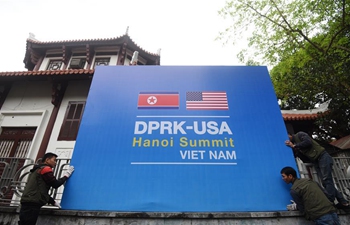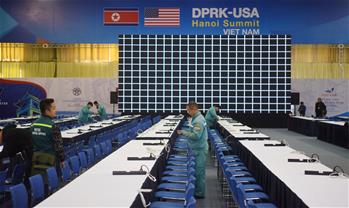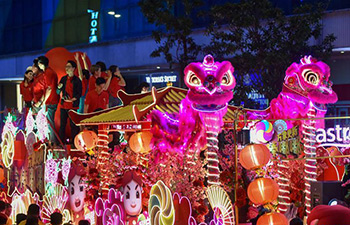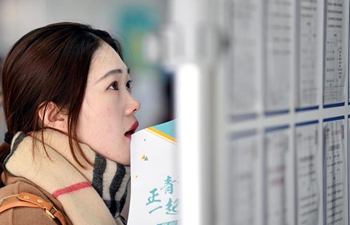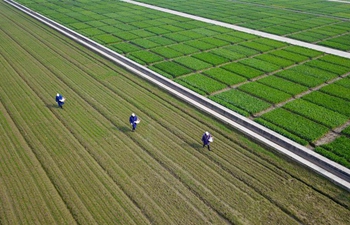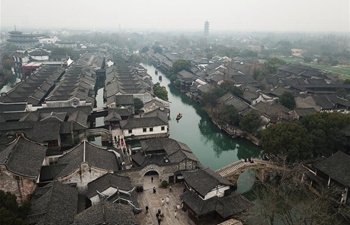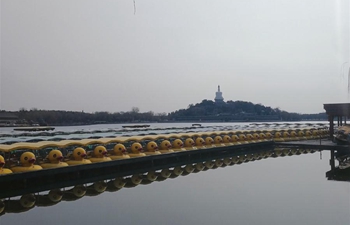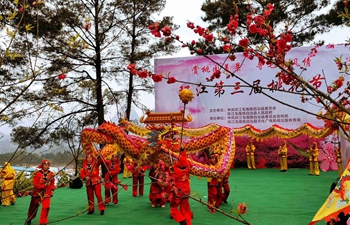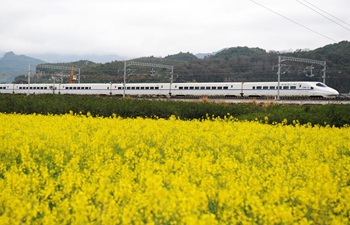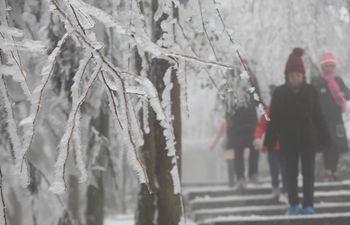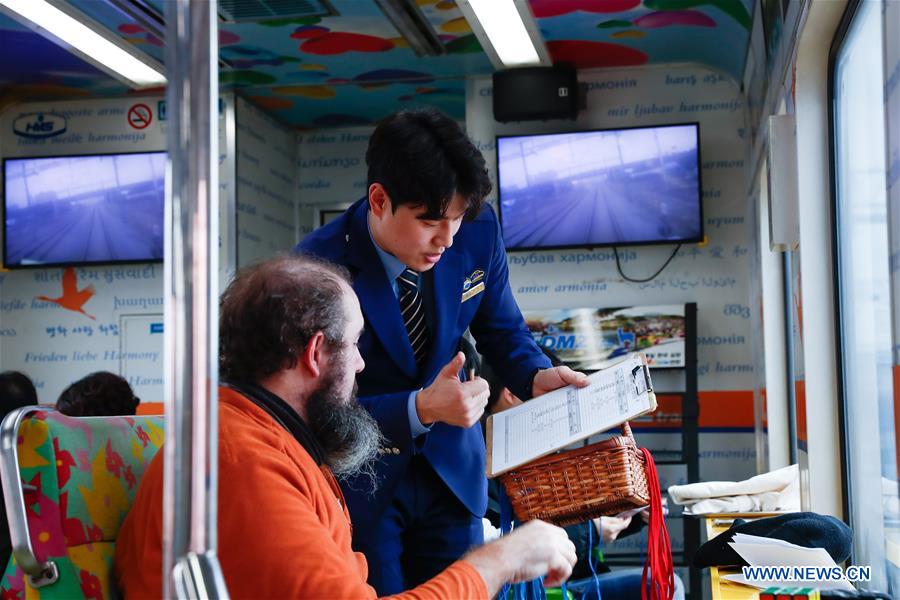
Lee Tae-hyun (R), a trainman and tour guide, registers a passenger's information onboard a DMZ train, South Korea, Feb. 20, 2019. Created in 1953 when the three-year Korean War ended with armistice, the Demilitarized Zone (DMZ) has long been a symbol of both confrontation and peace as tensions or rapprochement across the inter-Korean border can be felt firsthand in the 250-km-long strip of no-man's land. The DMZ Train departed Seoul Station for Dorasan Station, the northernmost station of the ROK just about 50 km north of Seoul and only 700 meters south of the southern boundary of the 4-km-wide DMZ. (Xinhua/Wang Jingqiang)
by Yoo Seungki
SEOUL, Feb. 26 (Xinhua) -- Bustling and crowded, Seoul Station in the Republic of Korea's capital Seoul was as busy as usual.
Tens of passengers, including some foreign tourists, stood on a platform waiting for the DMZ Train, a special line which runs once a day from Wednesday to Sunday carrying those who would like to have a firsthand look at the division of the two Koreas.
With a round-trip ticket in their hands, the passengers got on the three-car train at 10:15 a.m. (01:15 GMT) on Feb. 20, exactly a week before the planned second summit between Kim Jong Un, top leader of the Democratic People's Republic of Korea (DPRK) and U.S. President Donald Trump.
The Kim-Trump summit in Vietnam, the second one after the first in Singapore in June, raised further hope for peace on the Korean Peninsula that has been divided for decades.
Created in 1953 when the three-year Korean War ended with armistice, the Demilitarized Zone (DMZ) has long been a symbol of both confrontation and peace as tensions or rapprochement across the inter-Korean border can be felt firsthand in the 250-km-long strip of no-man's land.
The DMZ Train departed Seoul Station for Dorasan Station, the northernmost station of the ROK just about 50 km north of Seoul and only 700 meters south of the southern boundary of the 4-km-wide DMZ.
Among the passengers aboard the train were a couple from Finland, accompanied by their 25-year-old son who stayed in Seoul for seven months to study in a university.
Elemeri Helander told Xinhua on the running train that his parents picked a DMZ tour as there remains no place like it in the world. He said they heard about a peace process on the peninsula through news media.
During his stay in Seoul, Helander felt that the situation on the peninsula got rapidly better though he had little knowledge about the region's geopolitics before coming to the ROK.
The Finnish expressed hope that Kim and Trump would make good deals in Vietnam as the second meeting itself is a good sign, saying the DPRK was expected to open itself to more foreigners and do business with the outside world.
Provided by the Korean National Railroad (KORAIL), the DMZ tour package includes visits to a peace park and an observatory near the Dorasan Station.
Lee Tae-hyun, a trainman and tour guide, told Xinhua that the number of visitors has increased since the first summit between the leaders of the two Koreas was held in April last year.
Even before the summit, many old ROK residents who have long-lost relatives in the DPRK joined the tour program to glance at the DPRK soil at a closer distance. The separated families have been banned from entering the DPRK territory for the past decades as no peace treaty has been signed after the Korean War.
During the interview with Xinhua, the trainman mentioned a granny in her 80s who had left her family in the DPRK. He found her shedding tears and watching northward near an observatory while he was looking for her.
Lee said he hopes that the day would come soon when the separated families could freely cross the border to visit their hometowns and meet their relatives whenever they want.
The divided Korean Peninsula may not be unusual to ordinary ROK residents who have no family left behind in the DPRK. They might have been accustomed to the division since it has lasted for decades.
Instead, the peace mood on the peninsula seemed fresher to them. Chang Yong-chul, a Korean American who had lived in the United States for nearly 40 years, may be one of them.
Chang said he decided to go on the DMZ tour in the hope that the heavily armed buffer zone would disappear in the near future.
Bae Byung-hoon, a 43-year-old ROK resident, joined the DMZ tour program with his son and daughter for the first time to show his children the situation of the divided peninsula.
Bae expressed his hope for peace to come on the peninsula through the Kim-Trump summit, saying that he wished his children could tour the DPRK sometime in the future.
The train ran on the tracks for just over an hour, stopping at Imjingang Station where soldiers conducted security checks and the check of identification cards and passports. After the checks, the train left for Dorasan Station.
Jeon Hyeon-jong, chief of the Imjingang Station, told Xinhua that the train route between Seoul and Dorasan Station was launched as a commuter line in 2002 and was altered into the tour route in 2014.
The station master said the DMZ Train is a symbol of peace as it runs under the theme of transforming the war-scarred land of the DMZ into a land of peace and harmony.
Near Imjingang Station is Imjingak Nuri Peace Park, some 7 km south of the military demarcation line. The park just outside the ROK side of the DMZ is a relatively easy place to experience the divided peninsula, as no security checks are required.
The park was quiet and desolate on a dreary winter day. On weekends, lots of visitors would come, said a sales clerk at a gift shop inside the tourist spot.
The number of tourists recently rose as inter-Korean relations had been improving, she added.
What was visibly different from the past was the atmosphere surrounding the park, around which armed soldiers almost disappeared and tensions were alleviated significantly, said the shop assistant who declined to be identified.
The clerk, who has worked at the shop for about six years and has lived near the park, said situations on the peninsula were expected to get better through the upcoming DPRK-U.S. summit, though it could take time.
The gift shop stands right beside the gateway to Freedom Bridge, a barricaded bridge through which a number of prisoners returned home at the end of the Korean War.
On the way to the bridge sits a war-ravaged steam locomotive that was derailed by bombs during the Korean War. Along the barbed wire to the bridge hangs strips of cloth with messages hoping for peace and reunification between the two Koreas.
A signpost explaining the steam locomotive reads, "Let me, the steel horse, travel freely along the tracks."
The DMZ Train ran again to return to Seoul on the tracks, which were currently delinked from the DPRK but will hopefully be reconnected across the inter-Korean border.
